The principle of operation of an indirect heating boiler and an example of its manufacture by hand
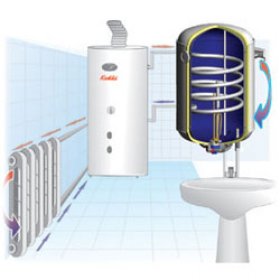
Indirect heating boilers are one of the best ways to provide a cottage or a private house with enough hot water. Compared with instantaneous heaters of various types, heating water using such a boiler is cheaper. However, acquiring an industrial model can be quite expensive, so many summer residents and homeowners prefer to make an indirect heating boiler with their own hands. Many cope with this task quite successfully.
Why is it needed and how does such a boiler work?
To understand how an ordinary indirect heating boiler works, it is enough to study the device of this device. It is a tank in which pipes are installed. A coolant circulates through the pipes, for example, used to heat a house. Cold water is supplied to the tank, it is gradually heated to a certain temperature and can be used for household needs.
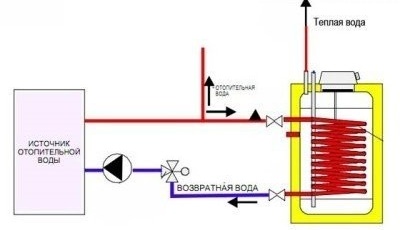
The diagram illustrates the device of an indirect heating boiler, which consists of a water tank and pipes inserted with a coolant
Owners of gas water heaters and electric flow heaters are well aware of the problems associated with their operation. After the water is open, you need to wait for a while until it warms up to the desired temperature. It also happens that the temperature of the water in the shower suddenly drops, if at that moment the faucet was opened in the kitchen, etc. But the indirect heating boiler eliminates these shortcomings, since the water in the device maintains a constant temperature.
There are several types of devices for a self-made indirect heating boiler:
- The most popular option is a coil made of a metal pipe. The coil is placed in the tank and the coolant is launched through it. Cold water is poured into the tank, which heats up upon contact with the coil.
- Pipes with a coolant can be placed not in the center of the tank, but along its walls, if it is more convenient. There are no other fundamental differences from the first version of the indirect heating boiler in this case.
- You can do without pipes at all, and use two containers of different diameters. They are inserted one into the other, water is supplied to the smaller tank for heating, and the coolant circulates in the space between the walls of the tanks.
Since the principle of operation of the indirect heating boiler is quite simple, you can come up with your own version of this design.
Boiler manufacturing procedure
To make a home-made indirect heating boiler, you must:
- prepare the container;
- make a coil;
- perform thermal insulation work;
- assemble the structure;
- connect the coil to the heating system of the house;
- connect the cold water supply;
- make a tap or wiring for warm water.
Stage # 1 - from what and how to make a tank?
The container in which warm water will be located can be made of plastic, stainless steel, enameled metal, etc.In a word, any corrosion-resistant tank is clean enough and of suitable size. To work with a metal tank, of course, you need a welding machine. Capacities coated with enamel or a glass-ceramic layer do not differ in special resistance to corrosion and may require replacement within a year after the start of operation. Stainless steel tanks are much more reliable and durable.
A gas cylinder is considered quite suitable for the manufacture of a boiler. It is best to purchase a new container, but if this is not possible, a used bottle will do. It just needs to be cut into two parts, and then carefully cleaned and primed the inner walls of the container. If this is not done, you will have to accept for several weeks the fact that the water coming from the boiler smells of propane.
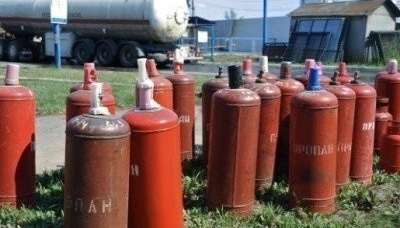
A suitable tank for an indirect heating boiler can be a gas cylinder. It is strong enough, has suitable sizes and configuration.
In the tank, make holes:
- for supplying cold water;
- to output hot water;
- two - for mounting a coil with a coolant.
Since no heating equipment is used in the summer, alternative sources of heating the coolant will be needed. Some have successfully used roof mounted solar panels for this purpose. A more cost-effective solution to the problem is the installation of an electric heater.
Stage # 2 - we solve the issue of thermal insulation
To reduce natural heat loss, a layer of good thermal insulation must be put on the outside of the boiler. Thermal insulation work, as a rule, is more convenient to carry out even before the design is assembled. As a heater, you can use any suitable material, even ordinary mounting foam. The insulation is fixed with glue, wire tie or in any other way. It is important that the entire boiler body is insulated, since the efficiency of the device depends on the quality of thermal insulation.
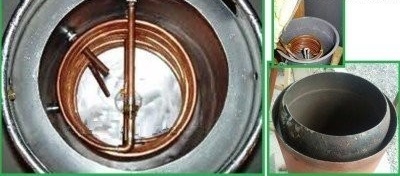
Sometimes thermal insulation is done using a larger tank. A boiler is inserted into it, and the space between the walls of these tanks is filled with insulation
Stage # 3 - making a coil
The coil is made of metal or plastic pipe of small diameter. The pipe is carefully wound on a cylindrical mandrel, which can be used as a sufficiently strong pipe of large diameter, a rounded log, etc.
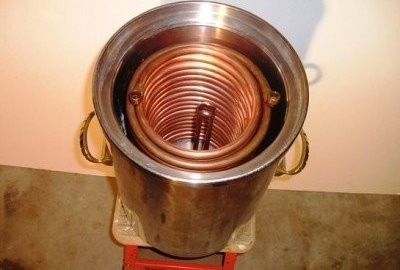
To make a coil for an indirect heating boiler, you can use both metal and plastic pipes of small diameter. They are placed in the center of the tank or along its walls.
The diameter of the coil itself and the number of turns are selected depending on the size and configuration of the tank. The larger the area of the coil with which the water contacts, the faster the water warms up to the required temperature.
Do not make special efforts when winding the pipe on the mandrel. If the coil is too tight against the mandrel, it will be difficult to remove.
During operation, various deposits accumulate on the surface of the heating element. About once a year, the coil should be cleaned from them.
Stage # 4 - assembly and connection of the structure
After all the elements are ready, you should assemble the device. If during the assembly the thermal insulation layer was damaged, it must be carefully restored.
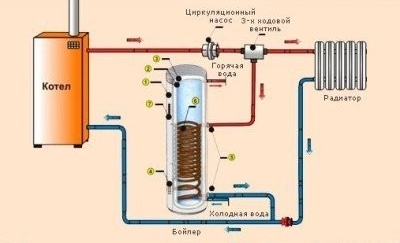
The coil is connected to the home heating system, then the cold water supply pipes are mounted. For hot water, a faucet is usually installed or immediately wired to the bathroom, kitchen sink, etc.
To install such a boiler on the wall, you can use brackets. To secure the structure, special “ears” are welded to the metal tank, which are made of a steel corner. It remains to securely attach the device in a convenient place and enjoy a full hot water supply without unnecessary costs.
Video example of the manufacture of such a boiler
Interesting details of the manufacture of an indirect heating boiler are presented in the video material:
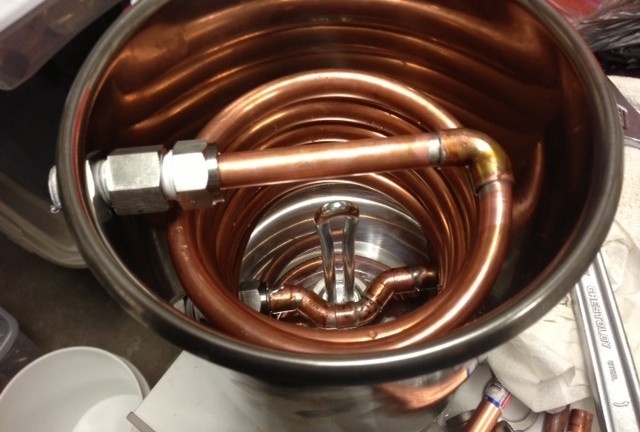
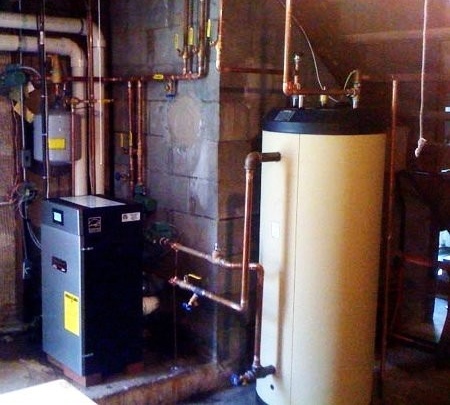

7 comments